Effectiveness of a Dam-Breach Flood Alert in Mitigating Life Losses: A Spatiotemporal Sectorisation Analysis in a High-Density Urban Area in Brazil
Abstract
:1. Introduction
2. Case Study
3. Materials and Methods
3.1. Dynamic Flood Evaluation
3.2. Exposure and Vulnerability Analysis of the Valley
3.3. Warning and Evacuation Scenarios
3.4. Sectorisation Scenarios and LOL Estimation
4. Results and Discussion
5. Conclusions
6. Further Research
Author Contributions
Funding
Data Availability Statement
Conflicts of Interest
References
- Ge, W.; Sun, H.; Zhang, H.; Li, Z.; Guo, X.; Wang, X.; Qin, Y.; Gao, W.; van Gelder, P. Economic Risk Criteria for Dams Considering the Relative Level of Economy and Industrial Economic Contribution. Sci. Total Environ. 2020, 725, 138139. [Google Scholar] [CrossRef] [PubMed]
- Sarchani, S.; Koutroulis, A.G. Probabilistic Dam Breach Flood Modeling: The Case of Valsamiotis Dam in Crete. Nat. Hazards 2022, 114, 1763–1814. [Google Scholar] [CrossRef]
- Mishra, A.; Mukherjee, S.; Merz, B.; Singh, V.P.; Wright, D.B.; Villarini, G.; Paul, S.; Kumar, D.N.; Khedun, C.P.; Niyogi, D.; et al. An Overview of Flood Concepts, Challenges, and Future Directions. J. Hydrol. Eng. 2022, 27, 2164. [Google Scholar] [CrossRef]
- Chai, J.; Wu, H.-Z. Prevention/Mitigation of Natural Disasters in Urban Areas. Smart Constr. Sustain. Cities 2023, 1, 4. [Google Scholar] [CrossRef]
- Zheng, Q. Method for a New Risk Assessment of Urban Inundation: G-DEMATEL-AHP. MethodsX 2023, 10, e101997. [Google Scholar] [CrossRef]
- Jonkman, S.N.; Van Gelder, P.H.A.J.M.; Vrijling, J.K. An Overview of Quantitative Risk Measures for Loss of Life and Economic Damage. J. Hazard Mater 2003, 99, 1–30. [Google Scholar] [CrossRef]
- CRED; UNISDR. Economic Losses, Poverty and Disasters 1998–2017; UNISDR: Geneva, Switzerland, 2018. [Google Scholar]
- Zhang, J.; Xu, W.; Liao, X.; Zong, S.; Liu, B. Global Mortality Risk Assessment from River Flooding under Climate Change. Environ. Res. Lett. 2021, 16, 064036. [Google Scholar] [CrossRef]
- Hu, P.; Zhang, Q.; Shi, P.; Chen, B.; Fang, J. Flood-Induced Mortality across the Globe: Spatiotemporal Pattern and Influencing Factors. Sci. Total Environ. 2018, 643, 171–182. [Google Scholar] [CrossRef]
- Merz, B.; Blöschl, G.; Vorogushyn, S.; Dottori, F.; Aerts, J.C.J.H.; Bates, P.; Bertola, M.; Kemter, M.; Kreibich, H.; Lall, U.; et al. Causes, Impacts and Patterns of Disastrous River Floods. Nat. Rev. Earth Environ. 2021, 2, 592–609. [Google Scholar] [CrossRef]
- Hammond, M.J.; Chen, A.S.; Djordjević, S.; Butler, D.; Mark, O. Urban Flood Impact Assessment: A State-of-the-Art Review. Urban Water J. 2015, 12, 14–29. [Google Scholar] [CrossRef]
- Kreibich, H.; Van Loon, A.F.; Schröter, K.; Ward, P.J.; Mazzoleni, M.; Sairam, N.; Abeshu, G.W.; Agafonova, S.; AghaKouchak, A.; Aksoy, H.; et al. The Challenge of Unprecedented Floods and Droughts in Risk Management. Nature 2022, 608, 80–86. [Google Scholar] [CrossRef]
- Kreibich, H.; Hudson, P.; Merz, B. Knowing What to Do Substantially Improves the Effectiveness of Flood Early Warning. Bull. Am. Meteorol. Soc. 2021, 102, E1450–E1463. [Google Scholar] [CrossRef]
- Thieken, A.H.; Bubeck, P.; Heidenreich, A.; von Keyserlingk, J.; Dillenardt, L.; Otto, A. Performance of the Flood Warning System in Germany in July 2021—Insights from Affected Residents. Nat. Hazards Earth Syst. Sci. 2023, 23, 973–990. [Google Scholar] [CrossRef]
- Lumbroso, D.; Davison, M. Use of an Agent-Based Model and Monte Carlo Analysis to Estimate the Effectiveness of Emergency Management Interventions to Reduce Loss of Life during Extreme Floods. J. Flood Risk Manag. 2018, 11, S419–S433. [Google Scholar] [CrossRef]
- Rotta, L.H.S.; Alcântara, E.; Park, E.; Negri, R.G.; Lin, Y.N.; Bernardo, N.; Mendes, T.S.G.; Souza Filho, C.R. The 2019 Brumadinho Tailings Dam Collapse: Possible Cause and Impacts of the Worst Human and Environmental Disaster in Brazil. Int. J. Appl. Earth Obs. Geoinf. 2020, 90, 102–119. [Google Scholar] [CrossRef]
- Lumbroso, D.; Davison, M.; Body, R.; Petkovšek, G. Modelling the Brumadinho Tailings Dam Failure, the Subsequent Loss of Life and How It Could Have Been Reduced. Nat. Hazards Earth Syst. Sci. 2021, 21, 21–37. [Google Scholar] [CrossRef]
- Apel, H.; Vorogushyn, S.; Merz, B. Brief Communication: Impact Forecasting Could Substantially Improve the Emergency Management of Deadly Floods: Case Study July 2021 Floods in Germany. Nat. Hazards Earth Syst. Sci. 2022, 22, 3005–3014. [Google Scholar] [CrossRef]
- Silva, A.F.R.; Eleutério, J.C. Analysis of Flood Warning and Evacuation Efficiency by Comparing Damage and Life-Loss Estimates with Real Consequences Related to the São Francisco Tailings Dam Failure in Brazil. Nat. Hazards Earth Syst. Sci. 2023, 23, 3095–3110. [Google Scholar] [CrossRef]
- Ge, W.; Jiao, Y.; Wu, M.; Li, Z.; Wang, T.; Li, W.; Zhang, Y.; Gao, W.; van Gelder, P. Estimating Loss of Life Caused by Dam Breaches Based on the Simulation of Floods Routing and Evacuation Potential of Population at Risk. J. Hydrol. 2022, 612, 128059. [Google Scholar] [CrossRef]
- Jiao, H.; Li, W.; Ma, D. Assessment of Life Loss Due to Dam Breach Using Improved Variable Fuzzy Method. Sci. Rep. 2022, 12, 3237. [Google Scholar] [CrossRef]
- Friedman, D.G. Computer Simulation in Natural Hazard Assessment; Institute of Behavioral Science, University of Colorado: Boulder, CO, USA, 1975. [Google Scholar]
- Brown, C.A.; Graham, W.J. Assessing the Threat to Life from Dam Failure. J. Am. Water Resour. Assoc. 1988, 24, 1303–1309. [Google Scholar] [CrossRef]
- DeKay, M.L.; McClelland, G.H. Predicting Loss of Life in Cases of Dam Failure and Flash Flood. Risk Anal. 1993, 13, 193–205. [Google Scholar] [CrossRef]
- Graham, W. A Procedure for Estimating Loss of Life Caused by Dam Failure. Sediment; U.S. Department of the Interior Bureau of Reclamation: Denver, CO, USA, 1999. [Google Scholar]
- Aboelata, M.; Bowles, D.S. LIFESim: A Model for Estimating Dam Failure Life Loss; Utah State University: Logan, UT, USA, 2005. [Google Scholar]
- Johnstone, W.M.; Sakamoto, D.; Assaf, H.; Bourban, S. Architecture, Modelling Framework and Validation of BC Hydro’s Virtual Reality Life Safety Model. In Proceedings of the International Symposium on Stochastic Hydraulics, Nijmegen, The Netherlands, 23–24 May 2005; Volume 2005. [Google Scholar]
- Jonkman, S.N.; Vrijling, J.K.; Vrouwender, A.C.W.M. Methods for the Estimation of Loss of Life Due to Floods: A Literature Review and a Proposal for a New Method. Nat. Hazards 2008, 46, 353–389. [Google Scholar] [CrossRef]
- U.S. Department of the Interior Bureau of Reclamation. RCEM—Reclamation Consequence Estimating Methodology—Guidelines for Estimating Life Loss for Dam Safety Risk Analysis; U.S. Department of the Interior Bureau of Reclamation: Washington, DC, USA, 2015. [Google Scholar]
- Huang, D.; Yu, Z.; Li, Y. Calculation Method and Application of Loss of Life Caused by Dam Break in China. Nat. Hazards 2017, 85, 39–57. [Google Scholar] [CrossRef]
- Jonkman, S.N.; Maaskant, B.B.; Kolen, B.B.; Needham, J.T.J. Loss of Life Estimation—Review, Developments and Challenges. In Proceedings of the III European Conference on Flood Risk Management, Lyon, France, 17–21 October 2016; Volume 7. [Google Scholar]
- Zhuo, L.; Han, D. Agent-Based Modelling and Flood Risk Management: A Compendious Literature Review. J. Hydrol. 2020, 591, 125600. [Google Scholar] [CrossRef]
- USACE HEC-LifeSim. Life Loss Estimation. User’s Manual—Version 1.0.1; USACE: Davis, CA, USA, 2018. [Google Scholar]
- Needham, J.; Fields, W.; Lehman, W. The US Army Corps of Engineers Scalable Approach to Estimating Loss of Life from Flooding. In Proceedings of the III European Conference on Flood Risk Management, Lyon, France, 17–21 October 2016; p. 6. [Google Scholar]
- Hill, P.; Kavanagh, C.; Lang, S. Applications of Simulation Model to Estimate Potential Loss of Life. In Proceedings of the XXVI International Congress on Large Dams, Viena, Austria, 1–7 July 2018. [Google Scholar]
- Kalinina, A.; Spada, M.; Burgherr, P. Alternative Life-Loss Rates for Failures of Large Concrete and Masonry Dams in Mountain Regions of OECD Countries. In Proceedings of the XXVIII International European Safety and Reliability Conference, ESREL 2018, Trondheim, Norway, 17–21 June 2018; p. 9. [Google Scholar]
- Leong-Cuzack, T.; Nielsen, C.; Kavanagh, C.; Watt, S. Quantitative Assessment of Dam Safety Emergency Management Using HEC-LifeSim: Is It Feasible? In Proceedings of the Australian Committee on Large Dams Conference, Auckland, New Zealand, 9–12 October 2019; p. 11. [Google Scholar]
- Wang, H. Lessons Learnt From Evacuation Modelling for Dam Failure Consequence Assessments. In Proceedings of the Australian Committee on Large Dams Conference, Auckland, New Zealand, 9–12 October 2019; p. 9. [Google Scholar]
- Tomura, S.; Chiba, M.; Yamamoto, T.; Uemura, F.; Masuya, S.; Omura, N.; Yoshida, T.; Takeda, A.; Hoshino, T.; Yamada, T.; et al. Fatality Estimation by Life Loss Evaluation Model for the Large-Scale Floods under Future Climate. In Proceedings of the 22nd Congress of the International Association for Hydro-Environment Engineering and Research-Asia Pacific Division, IAHR-APD 2020: “Creating Resilience to Water-Related Challenges”, Sapporo, Japan, 14–17 September 2020; pp. 1–8. [Google Scholar]
- El Bilali, A.; Taleb, A.; Boutahri, I. Application of HEC-RAS and HEC-LifeSim Models for Flood Risk Assessment. J. Appl. Water Eng. Res. 2021, 9, 336–351. [Google Scholar] [CrossRef]
- Kalinina, A.; Spada, M.; Burgherr, P. Quantitative Assessment of Uncertainties and Sensitivities in the Estimation of Life Loss Due to the Instantaneous Break of a Hypothetical Dam in Switzerland. Water 2021, 13, 22. [Google Scholar] [CrossRef]
- El Bilali, A.; Taleb, I.; Nafii, A.; Taleb, A. A Practical Probabilistic Approach for Simulating Life Loss in an Urban Area Associated with a Dam-Break Flood. Int. J. Disaster Risk Reduct. 2022, 2022, 103011. [Google Scholar] [CrossRef]
- Lang, S. Current Australian and International Practices for Dam Failure Consequence Assessments. In Proceedings of the Australian Committee on Large Dams Conference, Melbourne, Australia, 10 November–10 December 2018; Australian National Committee on Large Dams: Melbourne, VIC, Austrália, 2018; pp. 1–6. [Google Scholar]
- McClelland, D.M.; Bowles, D.S. Estimating Life Loss for Dam Safety Risk Assessment—A Review and New Approach; Institute for Water Resources, U.S. Army Corps of Engineers: Alexandria, VA, USA, 2002. [Google Scholar]
- Aboelata, M.; Bowles, D.S.; McClelland, D.M. A Model for Estimating Dam Failure Life Loss. In Proceedings of the Australian Committee on Large Dams Risk Workshop, Launceston, TAS, Australia, 10 October 2003; p. 18. [Google Scholar]
- Sorensen, J.H.; Lindell, M.K.; Baker, E.J.; Lehman, W.P. Community Response to Hurricane Threat: Estimates of Warning Issuance Time Distributions. Weather Clim. Soc. 2020, 12, 837–846. [Google Scholar] [CrossRef]
- Lindell, M.K.; Sorensen, J.H.; Baker, E.J.; Lehman, W.P. Community Response to Hurricane Threat: Estimates of Warning Diffusion Time Distributions. Weather Clim. Soc. 2021, 22, 04021007. [Google Scholar] [CrossRef]
- Koll, C.; Lindell, M.K.; Chen, C.; Wang, H. Emergency Warning Dissemination in a Multiplex Social Network. JASSS 2023, 26, 4946. [Google Scholar] [CrossRef]
- Lindell, M.K.; Sorensen, J.H.; Baker, E.J.; Lehman, W.P. Community Response to Hurricane Threat: Estimates of Household Evacuation Preparation Time Distributions. Transp. Res. D Transp. Environ. 2020, 85, 102457. [Google Scholar] [CrossRef]
- Chen, C.; Koll, C.; Wang, H.; Lindell, M.K. An Interdisciplinary Agent-Based Evacuation Model: Integrating the Natural Environment, Built Environment, and Social System for Community Preparedness and Resilience. Nat. Hazards Earth Syst. Sci. 2023, 23, 733–749. [Google Scholar] [CrossRef]
- Alaeddine, H.; Serrhini, K.; Maizia, M.; Néron, E. A Spatiotemporal Optimization Model for the Evacuation of the Population Exposed to Flood Hazard. Nat. Hazards Earth Syst. Sci. 2015, 15, 687–701. [Google Scholar] [CrossRef]
- Lee, Y.H.; Kim, H.I.; Han, K.Y.; Hong, W.H. Flood Evacuation Routes Based on Spatiotemporal Inundation Risk Assessment. Water 2020, 12, 2271. [Google Scholar] [CrossRef]
- Bopp, E.; Douvinet, J. Alerting People Prioritising Territories over Technologies. A Design Framework for Local Decision Makers in France. Appl. Geogr. 2022, 146, 102769. [Google Scholar] [CrossRef]
- Vianini Neto, L. Estudo de Ruptura Da Barragem Da Pampulha, Em Belo Horizonte: Retroanálise Da Brecha Do Acidente de 1954 e Ruptura Hipotética Nas Condições Atuais. Master’s Thesis, Federal University of Minas Gerias, Belo Horizonte, Brazil, 2016. [Google Scholar]
- Silva, T.F.G.; Vinçon-Leite, B.; Giani, A.; Figueredo, C.C.; Petrucci, G.; Lemaire, B.; Von Sperling, E.; Tassin, B.; Seidl, M.; Khac, V.T.; et al. Modelagem Da Lagoa Da Pampulha: Uma Ferramenta Para Avaliar o Impacto Da Bacia Hidrográfica Na Dinâmica Do Fitoplâncton. Eng. Sanit. Ambient. 2016, 21, 95–108. [Google Scholar] [CrossRef]
- Psomiadis, E.; Tomanis, L.; Kavvadias, A.; Soulis, K.X.; Charizopoulos, N.; Michas, S. Potential Dam Breach Analysis and Flood Wave Risk Assessment Using HEC-RAS and Remote Sensing Data: A Multicriteria Approach. Water 2021, 13, 364. [Google Scholar] [CrossRef]
- Froehlich, D.C. Embankment Dam Breach Parameters and Their Uncertainties. J. Hydraul. Eng. 2008, 134, 1708–1721. [Google Scholar] [CrossRef]
- Brunner, G.W. HEC-RAS. River Analysis System. Hydraulic Reference Manual—Version 6.0; U.S. Army Corps of Engineers: Davis, CA, USA, 2021. [Google Scholar]
- Merz, B.; Kreibich, H.; Schwarze, R.; Thieken, A. Review Article “Assessment of Economic Flood Damage”. Nat. Hazards Earth Syst. Sci. 2010, 10, 1697–1724. [Google Scholar] [CrossRef]
- De Moel, H.; Jongman, B.; Kreibich, H.; Merz, B. Flood Risk Assessments at Different Spatial Scales. Mitig. Adapt. Strat. Glob. Chang. 2015, 20, 865–890. [Google Scholar] [CrossRef] [PubMed]
- Mauro, M.D.; De Bruijn, K.M.; Meloni, M. Quantitative Methods for Estimating Flood Fatalities: Towards the Introduction of Loss-of-Life Estimation in the Assessment of Flood Risk. Nat. Hazards 2012, 63, 1083–1113. [Google Scholar] [CrossRef]
- Paprotny, D.; Mengel, M. Population, Land Use and Economic Exposure Estimates for Europe at 100 m Resolution from 1870 to 2020. Sci. Data 2023, 10, 372. [Google Scholar] [CrossRef] [PubMed]
- Sorensen, J.; Mileti, D. First Alert and/or Warning Issuance Time Estimation for Dam Breaches, Controlled Dam Releases, and Levee Breaches or Overtopping; U.S. Army Corps of Engineers: Davis, CA, USA, 2015. [Google Scholar]
- Sorensen, J.; Mileti, D. First Alert or Warning Diffusion Time Estimation for Dam Breaches, Controlled Dam Releases and Levee Breaches or Overtopping; U.S. Army Corps of Engineers: Davis, CA, USA, 2015. [Google Scholar]
- Sorensen, J.; Mileti, D. Protective Action Initiation Time Estimation for Dam Breaches, Controlled Dam Releases, and Levee Breaches or Overtopping; U.S. Army Corps of Engineers: Davis, CA, USA, 2015. [Google Scholar]
- Needham, J.; Sorensen, J.; Mileti, D.; Lang, S. Warning and Mobilization of Populations at Risk of Dam Failure. In Proceedings of the ANCOLD Conference, Adelaide, Australia, 17–19 October 2016; pp. 1–10. [Google Scholar]
- Greenshields, B.D.; Channing, W.; Miller, H. A Study of Traffic Capacity. In Proceedings of the XIV Annual Meeting of the Highway Research Board, Washington, DC, USA, 18–20 November 1935. [Google Scholar]
- Dijkstra, E.W. A Note on Two Problems in Connexion with Graphs. Numer. Math. 1959, 1, 269–271. [Google Scholar] [CrossRef]
- USACE LifeSim. Version 2.0. Hydrologic Engineering Center; U.S. Army Corps of Engineers: Davis, CA, USA, 2021. [Google Scholar]
- Sorensen, J.; Mileti, D. Influence Weights and Measures for the Factors Shaping First Alert/Warning Delay, Diffusion and Protective Action Initiation Curves for Dam Breaches, Controlled Dam Releases, and Levee Breaches or Overtopping; U.S. Army Corps of Engineers: Davis, CA, USA, 2015. [Google Scholar]
- Sorensen, J.; Mileti, D. Interview Schedule. Community Warning Issuance, Diffusion, and Protective Action Initiation Estimation; U.S. Army Corps of Engineers: Davis, CA, USA, 2015. [Google Scholar]
- Bello, D.; Alcayaga, H.; Caamaño, D.; Pizarro, A. Influence of Dam Breach Parameter Statistical Definition on Resulting Rupture Maximum Discharge. Water 2022, 14, 1776. [Google Scholar] [CrossRef]
- Rizzo, C.; Maranzoni, A.; D’Oria, M. Probabilistic Mapping and Sensitivity Assessment of Dam-Break Flood Hazard. Hydrol. Sci. J. 2023, 68, 700–718. [Google Scholar] [CrossRef]
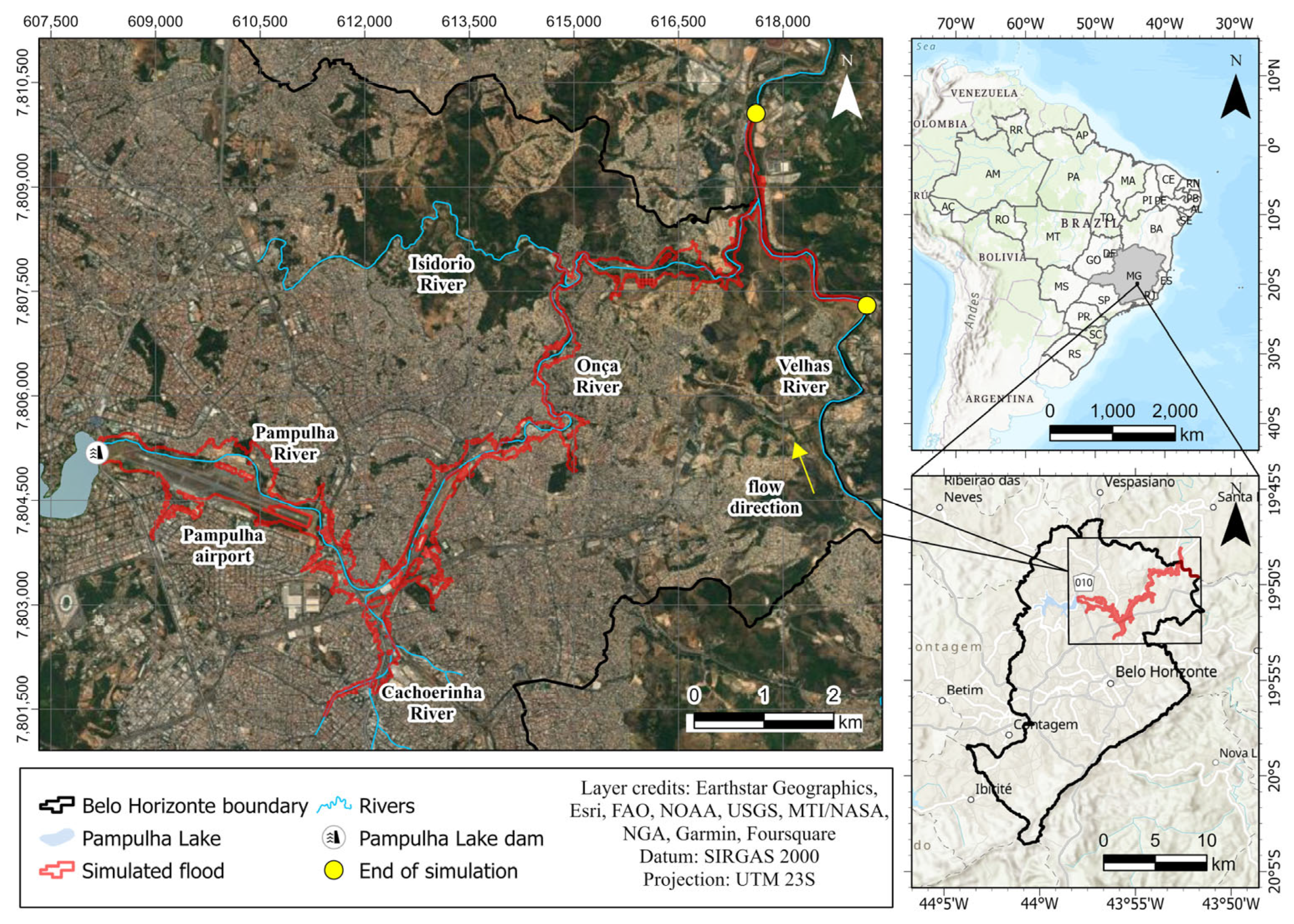

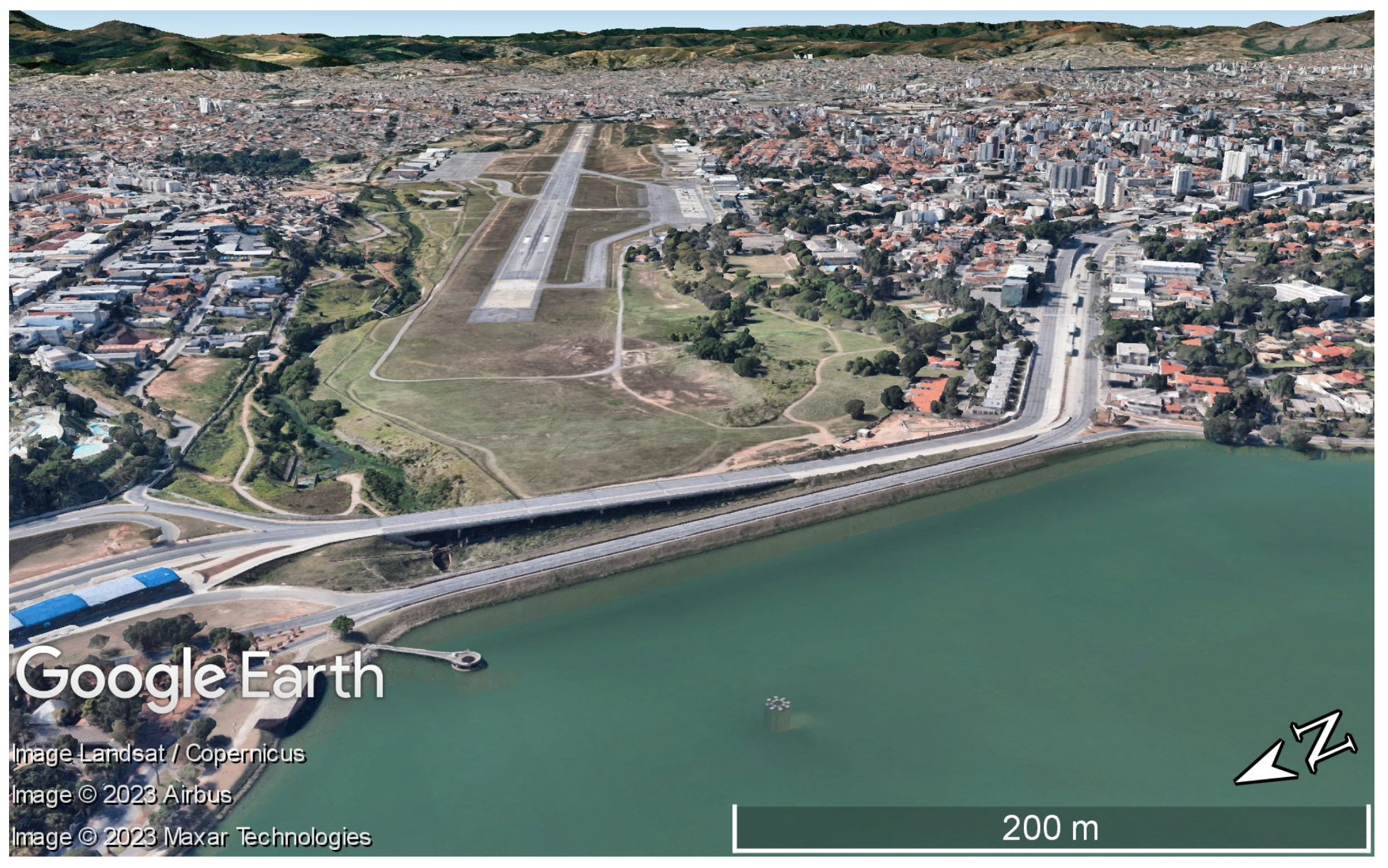


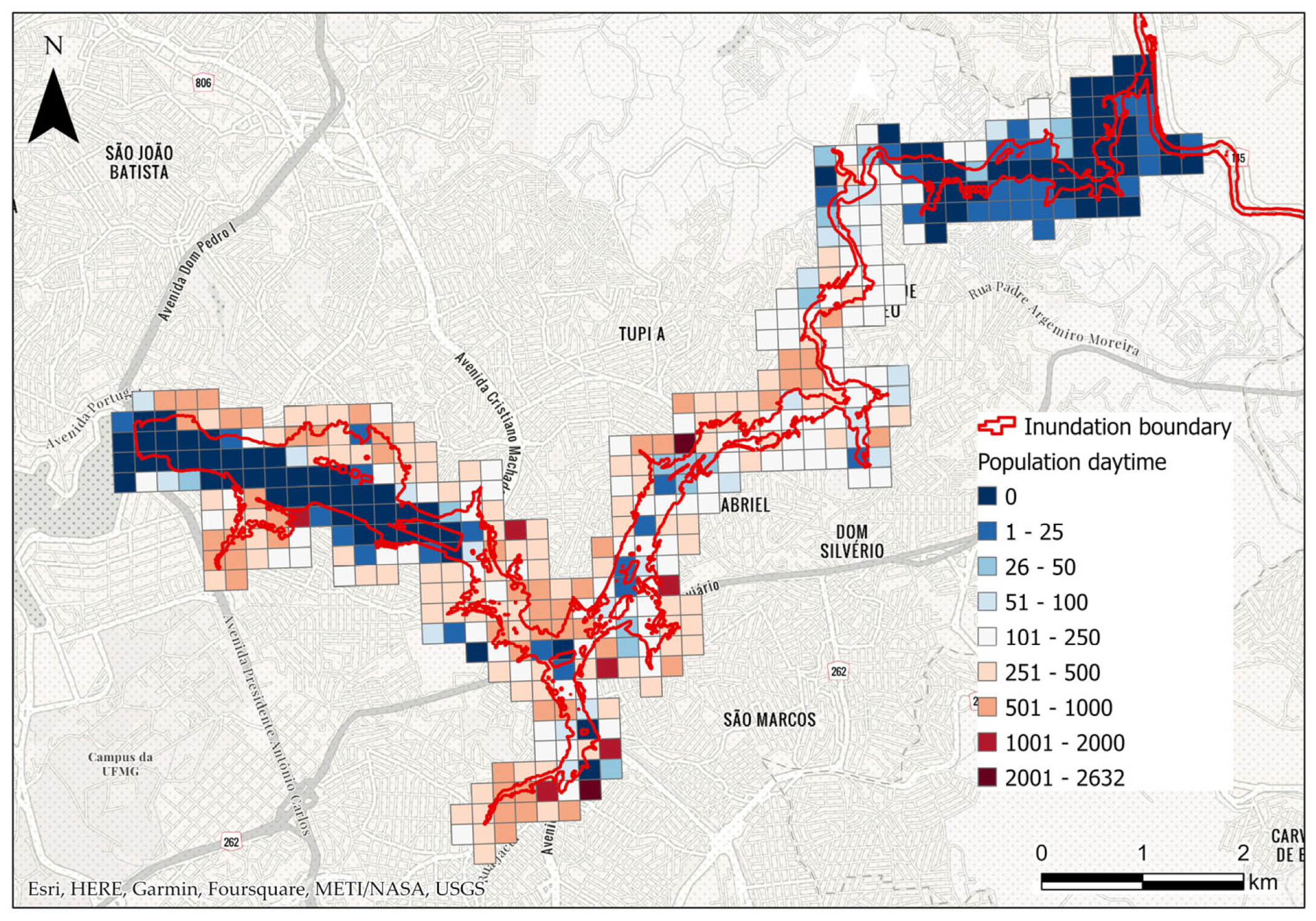
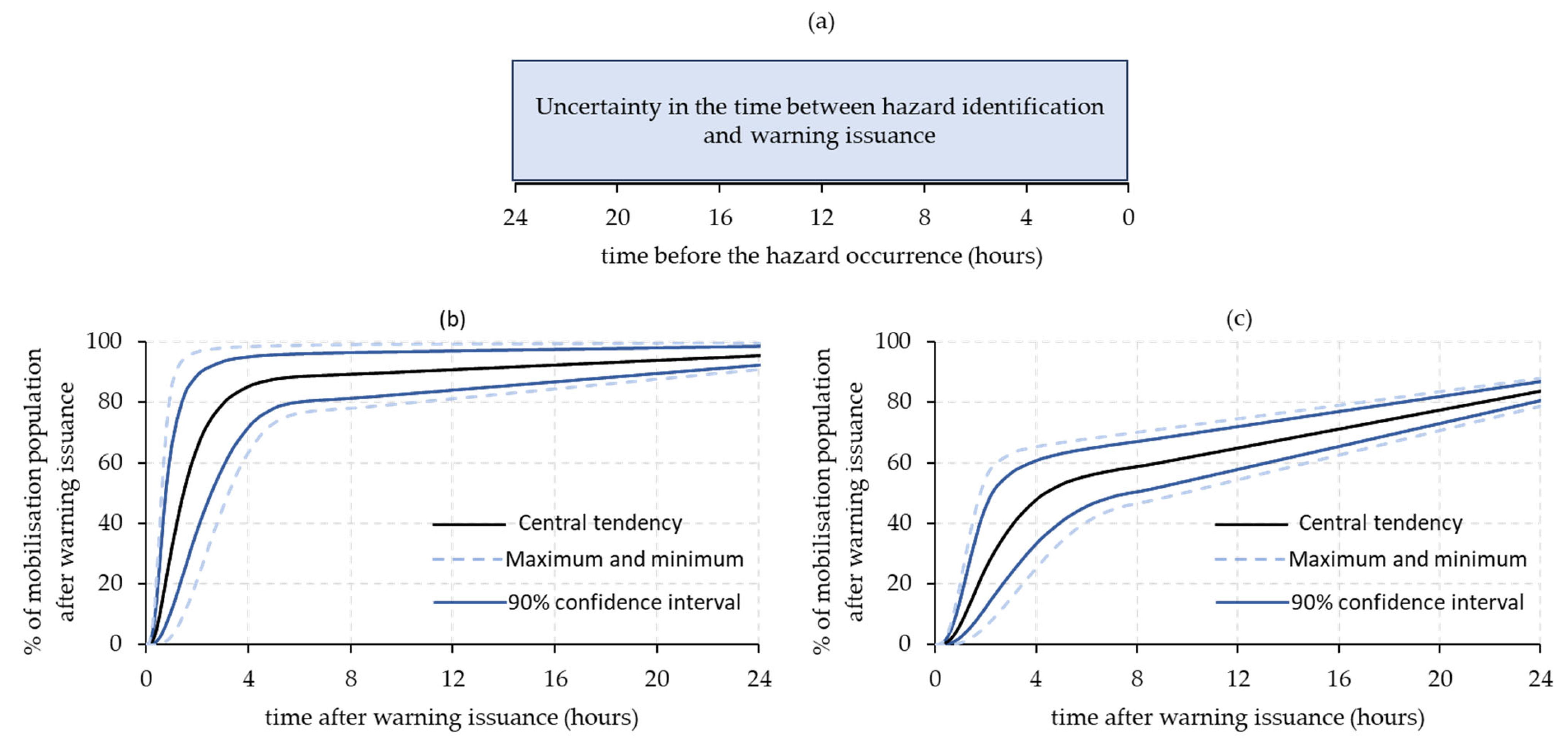
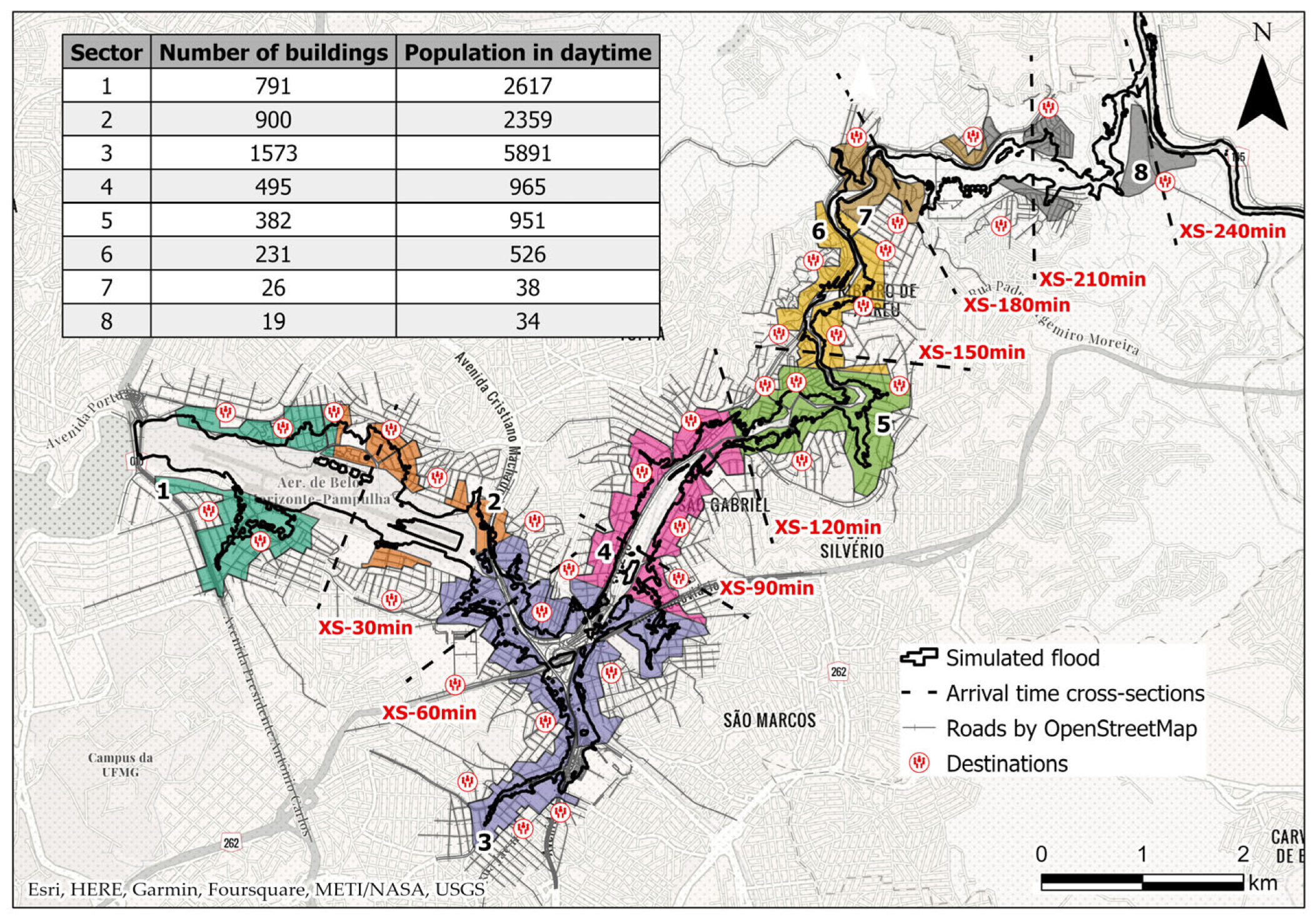
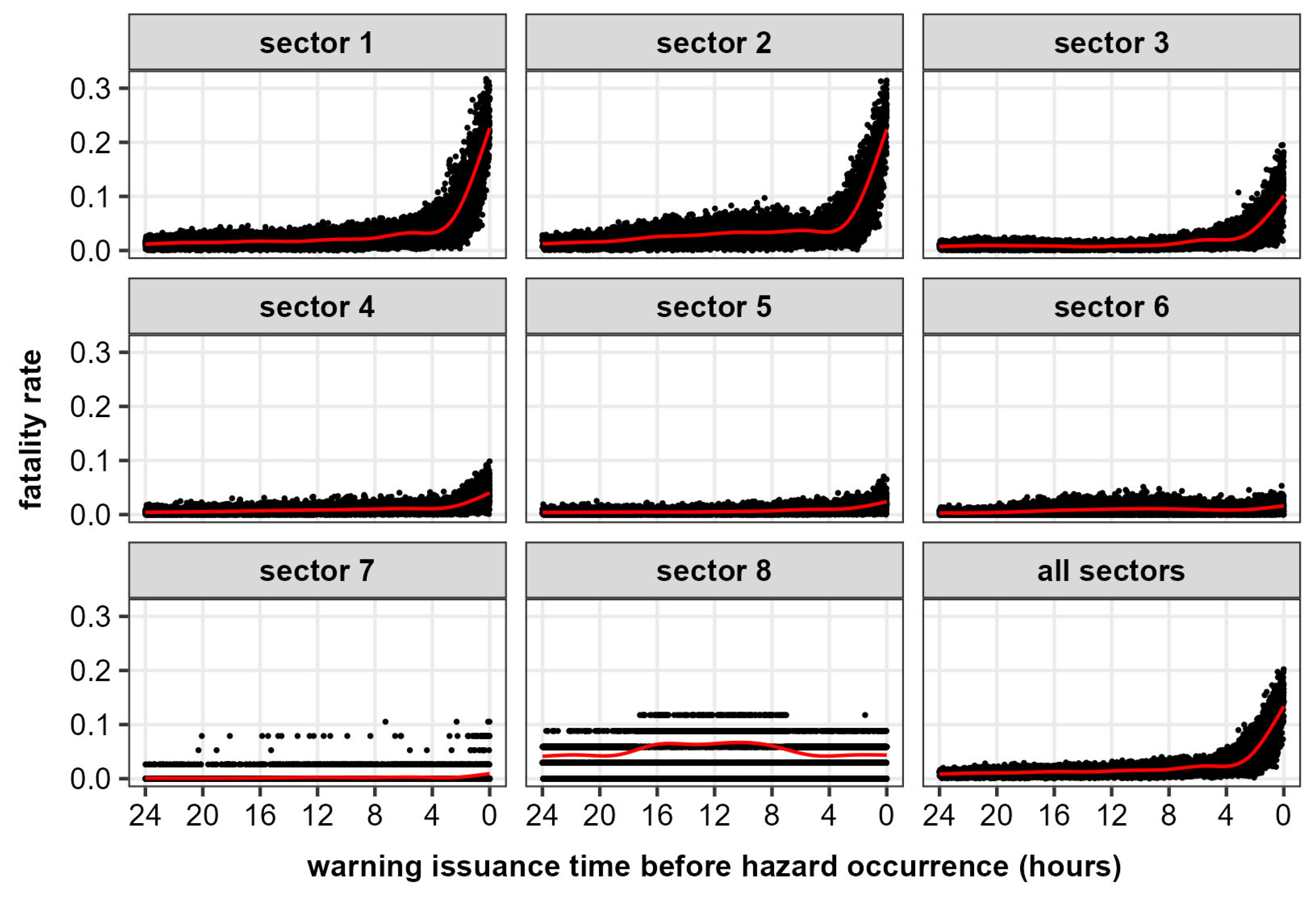


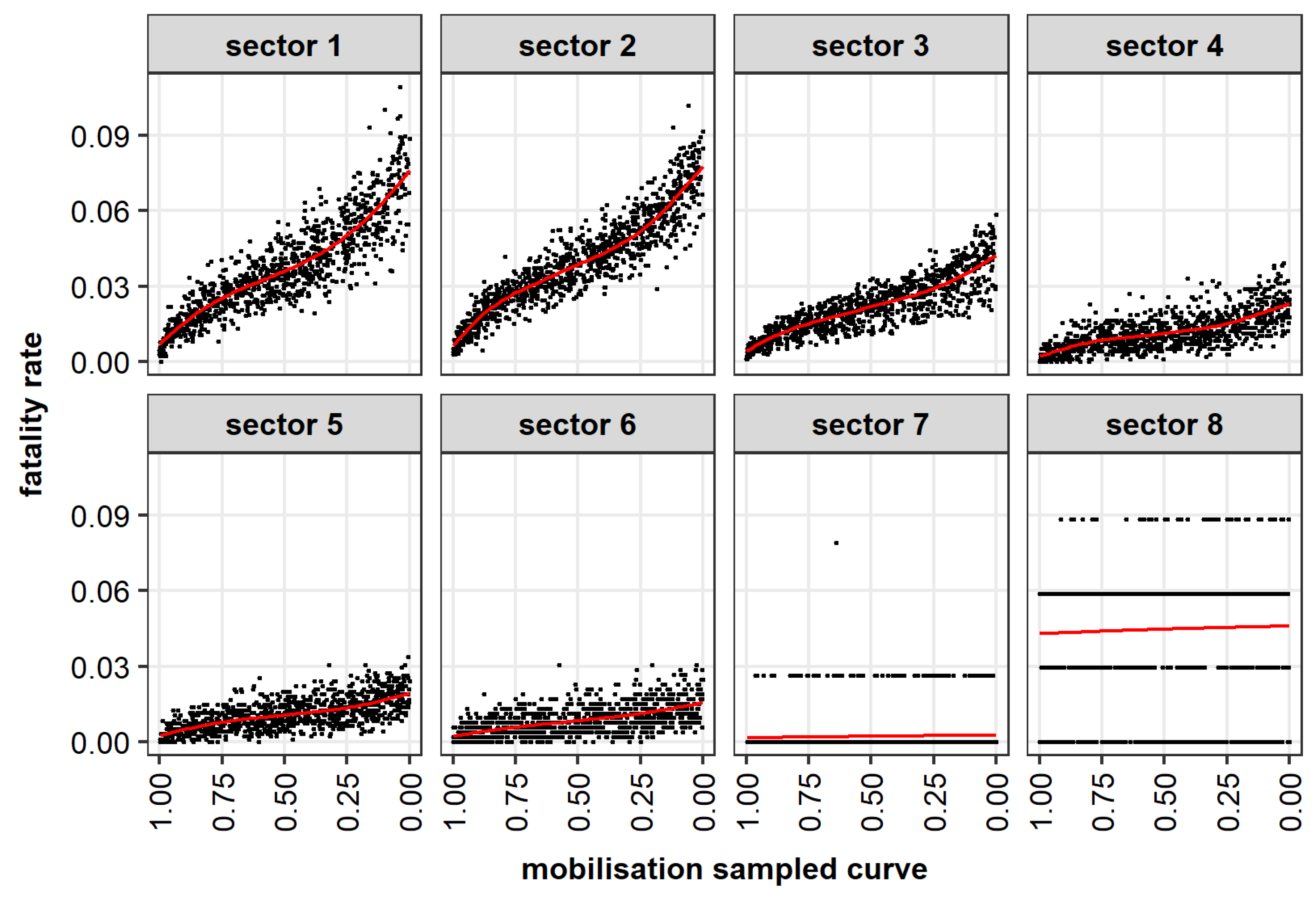

| Parameter | Value |
|---|---|
| Crest length (m) | 450 |
| Height (m) | 20 |
| Crest elevation (m) | 805 |
| Maximum operation elevation (m) | 801 |
| Volume at maximum operation elevation (hm3) | 10 |
| Cross-Section | Average Maximum Depth (m) | Average Maximum Velocity (m/s) |
|---|---|---|
| XS-30 min | 4.8 | 1.0 |
| XS-60 min | 3.9 | 0.9 |
| XS-90 min | 2.4 | 0.9 |
| XS-120 min | 2.8 | 1.2 |
| XS-150 min | 4.6 | 2.9 |
| XS-180 min | 4.1 | 1.3 |
| XS-210 min | 4.0 | 0.5 |
| XS-240 min | 4.8 | 0.9 |
| Sector | High Mobilisation | Low Mobilisation | ||||||||||||
|---|---|---|---|---|---|---|---|---|---|---|---|---|---|---|
| 0.05 | 0.25 | 0.50 | 0.75 | 0.90 | 0.95 | 0.99 | 0.05 | 0.25 | 0.50 | 0.75 | 0.90 | 0.95 | 0.99 | |
| 1 | 13 | 33 | 53 | 83 | 176 | 345 | 638 | 106 | 150 | 189 | 276 | 450 | 578 | 738 |
| 2 | 16 | 38 | 64 | 102 | 165 | 304 | 574 | 108 | 175 | 258 | 327 | 433 | 542 | 692 |
| 3 | 16 | 38 | 61 | 98 | 200 | 341 | 700 | 128 | 171 | 214 | 347 | 609 | 774 | 1024 |
| 4 | 0 | 4 | 7 | 13 | 19 | 26 | 49 | 11 | 21 | 30 | 42 | 54 | 65 | 86 |
| 5 | 0 | 2 | 5 | 9 | 14 | 18 | 32 | 9 | 15 | 21 | 31 | 44 | 53 | 68 |
| 6 | 0 | 1 | 3 | 6 | 10 | 12 | 17 | 4 | 9 | 15 | 21 | 26 | 29 | 35 |
| 7 | 0 | 0 | 0 | 0 | 0 | 1 | 1 | 0 | 0 | 0 | 0 | 1 | 1 | 3 |
| 8 | 0 | 1 | 2 | 3 | 3 | 3 | 4 | 0 | 1 | 2 | 3 | 3 | 4 | 4 |
| All | 59 | 129 | 197 | 304 | 570 | 1032 | 1950 | 416 | 563 | 713 | 1037 | 1613 | 2023 | 2499 |
Disclaimer/Publisher’s Note: The statements, opinions and data contained in all publications are solely those of the individual author(s) and contributor(s) and not of MDPI and/or the editor(s). MDPI and/or the editor(s) disclaim responsibility for any injury to people or property resulting from any ideas, methods, instructions or products referred to in the content. |
© 2023 by the authors. Licensee MDPI, Basel, Switzerland. This article is an open access article distributed under the terms and conditions of the Creative Commons Attribution (CC BY) license (https://creativecommons.org/licenses/by/4.0/).
Share and Cite
Silva, A.F.R.; Eleutério, J.C. Effectiveness of a Dam-Breach Flood Alert in Mitigating Life Losses: A Spatiotemporal Sectorisation Analysis in a High-Density Urban Area in Brazil. Water 2023, 15, 3433. https://doi.org/10.3390/w15193433
Silva AFR, Eleutério JC. Effectiveness of a Dam-Breach Flood Alert in Mitigating Life Losses: A Spatiotemporal Sectorisation Analysis in a High-Density Urban Area in Brazil. Water. 2023; 15(19):3433. https://doi.org/10.3390/w15193433
Chicago/Turabian StyleSilva, André Felipe Rocha, and Julian Cardoso Eleutério. 2023. "Effectiveness of a Dam-Breach Flood Alert in Mitigating Life Losses: A Spatiotemporal Sectorisation Analysis in a High-Density Urban Area in Brazil" Water 15, no. 19: 3433. https://doi.org/10.3390/w15193433
APA StyleSilva, A. F. R., & Eleutério, J. C. (2023). Effectiveness of a Dam-Breach Flood Alert in Mitigating Life Losses: A Spatiotemporal Sectorisation Analysis in a High-Density Urban Area in Brazil. Water, 15(19), 3433. https://doi.org/10.3390/w15193433








